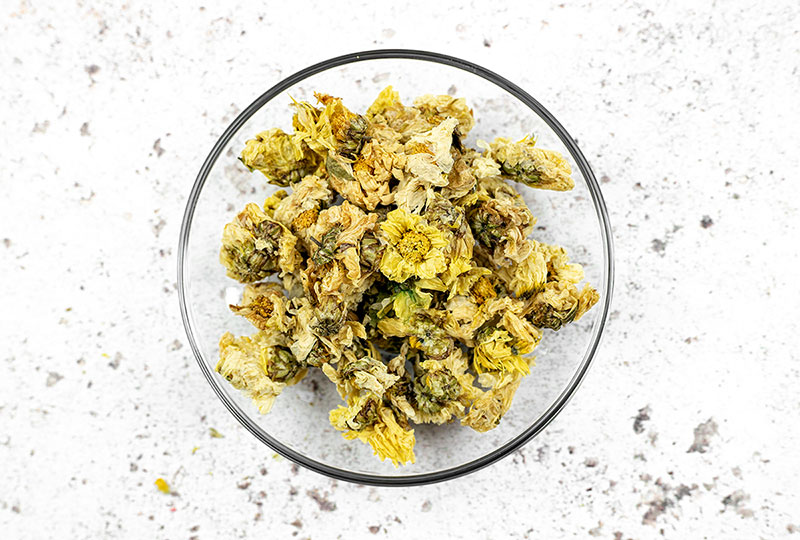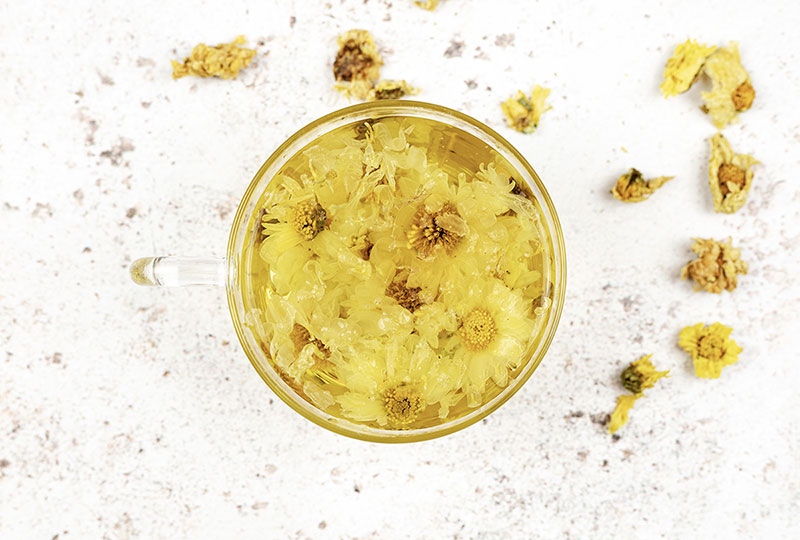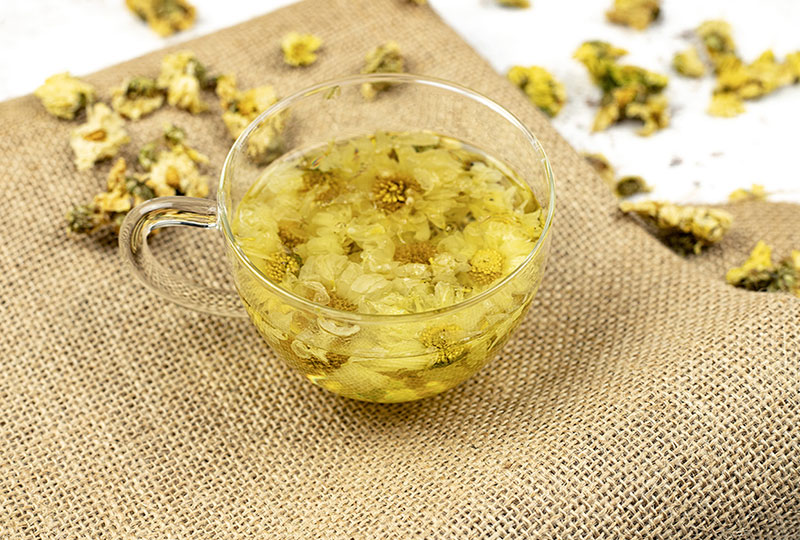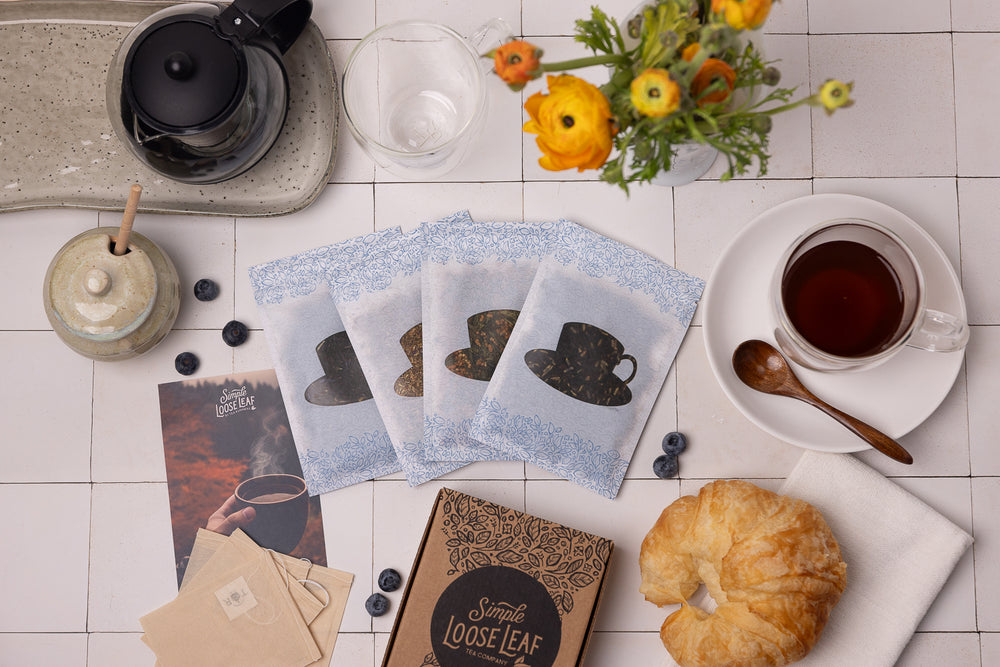How to Make Chrysanthemum Tea
What can be more relaxing and refreshing than a cup of tea that’s not only delicious, but pretty too? Chrysanthemum tea is a genuine delight among herbal teas. It’s highly popular in China, and a must try if you like delicate but flavorful floral teas.



[1] https://www.ncbi.nlm.nih.gov/pmc/articles/PMC6359479/ [2] https://www.ncbi.nlm.nih.gov/pmc/articles/PMC6359479/ [3] https://www.ncbi.nlm.nih.gov/pmc/articles/PMC6359479/ [4] https://www.ncbi.nlm.nih.gov/pmc/articles/PMC6359479/ [5] https://www.ncbi.nlm.nih.gov/pmc/articles/PMC6359479/ [6] http://www.aloki.hu/pdf/1706_1335513369.pdf
What is chrysanthemum tea?
Chrysanthemum tea is a herbal tea made by steeping dried chrysanthemum flowers in hot water. The most common type of chrysanthemum used for making tea is Chrysanthemum morifolium[1] with small yellow flowers. Although white chrysanthemum (bai ju hua) buds are available too, the yellow (ju hua) ones are more common. There are many types of chrysanthemum tea, and buds will vary in size, quality and price. This floral tea is one of the most popular floral teas in China and premium types may be quite expensive. Not only does chrysanthemum tea have a unique and beautiful appearance and refreshing flavor, it may provide many health benefits too. Chrysanthemum buds are very popular for making blooming tea as well. Blooming teas are artisan teas made with tea leaves and flowers tightly wrapped into a small ball that “blooms” in water. When you steep the tea ball in boiling water, it will expand into beautiful shapes made of tea leaves and flowers.
Tea Origins
Chrysanthemum tea originates from China and it’s an important flower in the Chinese traditional medicine. It’s grown in different provinces, with Anhui and Huangzhou producing some of the best chrysanthemum teas in the world. Chrysanthemum tea is common in other Asian countries too, especially in South Korea and Japan. This tea is often prepared with pure buds only, but it can sometimes be blended with Camellia sinensis teas, most commonly Chinese pu’erh tea.Tea Taste
Although the scent of dried chrysanthemum flowers may sometimes have a sharp, strong and medicinal scent, the brewed tea has a very delightful taste. Chrysanthemum tea has a very light and refreshing, sweet flavor and bright yellow color. If you don’t enjoy strong floral flavors of rose tea or jasmine tea, chrysanthemum tea may be a great tea for you. It’s not as intense, but still full of flavor. Some types may be slightly bitter with a sweet aftertaste, while others will have a sweet floral flavor with no bitterness. If you think your tea is too bitter, add a teaspoon of honey or brew it with other flowers or even berries, such as Goji berries.
Potential Health Benefits
Chrysanthemum tea is not only a delicious and beautiful tea, it’s one of the most important functional teas in China, South Korea and Japan. Is famous for its many potential health benefits and it’s been used in traditional medicines for centuries. Studies showed chrysanthemum tea may provide “anti-inflammatory, anti-pyretic, sedative, anti-arthritic, anti-hypertensive effect[2]” and “antioxidant, anti-inflammatory, antitumor, neuroprotective, and anti-allergic[3]” activity. One of the most important benefit from drinking chrysanthemum tea may be the cooling properties[4]. Because of its anti-pyretic property, It’s often used for treating symptoms of common cold, and in summer to offer an instant refreshment. Studies showed that chrysanthemum tea has a powerful free radical scavenging potential[5]. It may be very beneficial for cardiovascular health and help clear the skin and even act as an antibiotic to treat skin infections topically[6].Caffeine Content
Chrysanthemum tea is herbal tea made from flowers that are naturally caffeine free. A cup of pure chrysanthemum tea will not contain any caffeine. However, when chrysanthemum buds are blended with other types of tea, for example pu’erh, it will contain caffeine. Pure chrysanthemum tea is suitable for any time of the day or night. It’s very popular during summer and you can serve it as iced tea too.How to Make Chrysanthemum Tea
To make chrysanthemum tea you will need dried chrysanthemum buds, fresh spring water, a teapot or a mug and an infuser and a kettle. Bring water to a boil and let it cool for about 1 minute. Don’t use boiling water for making chrysanthemum tea. The maximum temperature for preparing this tea should be around 203°F. Use about 3-10 flowers (depending on their size) per cup of water and steep for 2-3 minutes. You can serve it with a bit of regular sugar, rock sugar or honey, hot or over ice. Although you can make chrysanthemum tea using any teapot, if possible, use gass teapot or glass cups to enjoy the fully opened flowers and wonderful bright yellow color of this herbal tea. If you want to add more flavor or enhance the health benefits, try making your own chrysanthemum tea blend with either green, black or pu’erh tea or by adding different berries or flowers.
Where to Buy
Chrysanthemum tea is available online and in specialized Asian tea shops and groceries shops. If you want to enjoy premium dried chrysanthemum flowers with less bitterness and more sweetness, specialized shops may offer greater variety. Tea blends containing chrysanthemum flowers are available too, as these beautiful little flowers may add a delightful sweet and floral note to real tea.Top blends with chrysanthemum flowers
1. Green Dragon A unique blend of fresh and sharp green tea and fruity flavors sprinkled with marigold petals and chrysanthemum flowers. This high caffeine tea is great on a hot summer’s day, served both hot or chilled. 2. Irish Cream This delicious cup of (decaf!) joy has a deep and warming soul. It will welcome you with rich cocoa and vanilla cream notes infused into a smooth, soft and earthy black tea base, while a pinch of chrysanthemum petals will give it just a touch of floral sweetness. 3. St. Andrews Blend St. Andrew’s Blend is a twist on an English Breakfast style tea, contains no caffeine and can be served with or without milk. With a touch of chrysanthemum, raspberry and lemon flavor, this tea is delicious, both hot and iced.Disclaimer: This article is for informational purposes only. It’s not intended to replace medical advice, diagnosis or treatment. Every person is different and may react to different herbs and teas differently. Never use teas or herbs to treat serious medical conditions on your own. Always seek professional medical advice before choosing home remedies.
References:
[1] https://www.ncbi.nlm.nih.gov/pmc/articles/PMC6359479/ [2] https://www.ncbi.nlm.nih.gov/pmc/articles/PMC6359479/ [3] https://www.ncbi.nlm.nih.gov/pmc/articles/PMC6359479/ [4] https://www.ncbi.nlm.nih.gov/pmc/articles/PMC6359479/ [5] https://www.ncbi.nlm.nih.gov/pmc/articles/PMC6359479/ [6] http://www.aloki.hu/pdf/1706_1335513369.pdf
More from:
SLL




Leave a comment